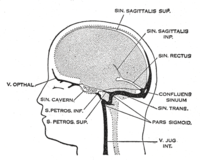
Photo from wikipedia
Background: Cerebral venous sinus thrombosis (CVST) is rare in children, increasingly being recognized of late due to advances in neuroimaging. The aim of the study was to describe the clinical,… Click to show full abstract
Background: Cerebral venous sinus thrombosis (CVST) is rare in children, increasingly being recognized of late due to advances in neuroimaging. The aim of the study was to describe the clinical, etiological, and imaging characteristics of CVST and its outcome in children. Study Design: A retrospective chart review of children with CVST in a tertiary hospital from January 2011 to December 2020. Results: Of the 35 patients enrolled, 26 (74.3%) patients were males. The mean age was 5.03 years with a range of 0.17–12 years. The common presenting symptoms were seizures in 18 (51.4%) followed by headache in 17 (48.6%), fever in 16 (45.7%), and vomiting in 15 (42.9%) children. Superior sagittal sinus was the commonest site of thrombus occlusion in 20 (57%), followed by transverse sinus in 18 (51.4%) patients. Multiple sinus involvement was noticed in one-half of the patients. The risk factors associated with CVST were head and neck infections in 15 (42.9%) children, inherited thrombophilia in 4 (11.6%), head trauma, iron deficiency anemia, leukemia with l-asparaginase therapy, acquired thrombophilia in 3 (8.6%) each, dehydration in 2 (5.7%), and dural arteriovenous fistula in one child. Two children (5.7%) died and one-third of the cohort had a poor outcome. Conclusions: Head and neck infections continue to be the common cause of CVST in children. Though mortality is low, CVST is associated with significant morbidity in children.
Journal Title: Annals of Indian Academy of Neurology
Year Published: 2021
Link to full text (if available)
Share on Social Media: Sign Up to like & get
recommendations!